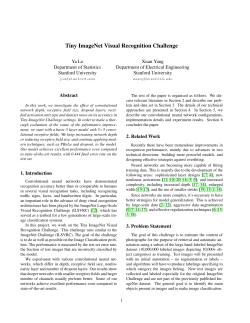
Neural Networks
Deep Networks Jin Sun * Some figures are from Andrew Ng’s cs294a course notes. * Some figures are from Alex Krizhevsky’s ImageNet paper. Zoo of Networks • Neural Networks • One layer neural network: logistic regression, perceptron • Multi-layer Perceptron, single hidden layer network: autoencoder • Deep neural networks • Convolutional Neural Networks: LeNet, ImageNet, R-CNN, MCDNN • Memory based neural networks: Recurrent Neural Networks, LSTM • Belief Networks • Boltzmann Machine, Restricted Boltzmann Machine • Deep Boltzmann Machine • Deep Belief Networks Key Concepts • Backpropagation, SGD • Non-linearity / Universal Approximator • Non convexity / Generalization • Going deep exponentially powerful • Vanishing (exploding) Gradient • Content addressable memory • Techniques • Generalization, constraints Forward propagation • From input layer to output layer • 𝑎(𝑙+1) = 𝑓(𝑊 (𝑙→𝑙+1) 𝑎(𝑙) ) • 𝑓 is the activation (squashing) function • Non-linear: logistic, tanh, ReLU, etc… • Usually bounds intermediate values • Pros and Cons • Loss function • Compute the error with target values • L2 loss, cross entropy loss Backward propagation • Gradient descent • 𝜕𝑙𝑜𝑠𝑠 𝜕𝑤 (𝑙→𝑙+1) = 𝜕𝑎(𝑙+1) 𝜕𝑤 (𝑙→𝑙+1) 𝑇 𝜕𝑎(𝑙+2) 𝜕𝑎(𝑙+1) 𝑇 ⋅⋅⋅ 𝜕𝑦 𝜕𝑎 𝑙𝑎𝑠𝑡 ℎ𝑖𝑑𝑑𝑒𝑛 𝑙𝑎𝑦𝑒𝑟 • Momentum Δ𝑤 𝑡 = −𝑙𝑟 ∗ 𝛻 𝑤 + 𝜂Δ𝑤 𝑡 − 1 𝑇 𝜕𝑙𝑜𝑠𝑠 ( ) 𝜕𝑦 ImageNet http://www.cs.toronto.edu/~fritz/absps/imagenet.pdf Convolutional Layer • Fixed size filter (kernel) scanning on the inputs. • 𝑎 = 𝑓( 𝑖,𝑗∈𝑘𝑒𝑟𝑛𝑒𝑙 𝑤𝑖,𝑗 𝑥𝑟+𝑖,𝑐+𝑗 ) • Detect local patterns • Low level features (lines, corners) in preceding layers • High level features (beard, hair, faces) in succeeding layers • Network perspective: • sparse connection, identical weights Line Detector Pooling Layer • Aggregating detections • The max (mean) value of the kernel • Network perspective: • sparse connection, identical weights Max Pooling Network Architecture ReLU activation • 𝑓 𝑧 = max(0, 𝑧) • Soft-plus: 𝑓 𝑧 = ln(1 + 𝑒 𝑧 ) Reduce Overfitting • Data augmentation • Horizontal Reflection • PCA • • • • Perform PCA on the set of RGB pixel values throughout the training set For each RGB pixel, add 𝑝1 , 𝑝2 , 𝑝3 𝛼1 𝜆1 , 𝛼2 𝜆2 , 𝛼3 𝜆3 ⊤ 𝛼 ∼ 𝒩(0,0.12 ) Object identity is invariant to changes in the intensity and color of the illumination • Dropout • Local Response Normalization 𝑖 = 𝑎𝑖 / 𝑘 + 𝛼 • 𝑏𝑥,𝑦 𝑥,𝑦 • Overlapping Pooling min(𝑁−1,𝑖+𝑛/2) 𝑗=max(0,𝑖−𝑛/2) 2 𝛽 𝑗 𝑎𝑥,𝑦 Dataset • ILSVRC: subset of ImageNet, ~1000 images in each of 1000 categories • 1.2 million training images • 50,000 validation images • 150,000 testing images • Down-sample images to fixed resolution: 256*256 • Extract 224*224 patches from 256*256 Results
© Copyright 2025





















